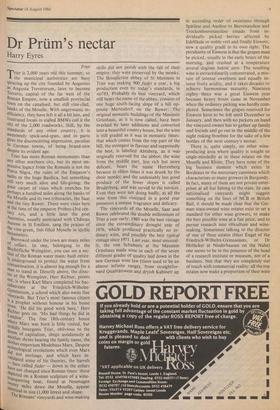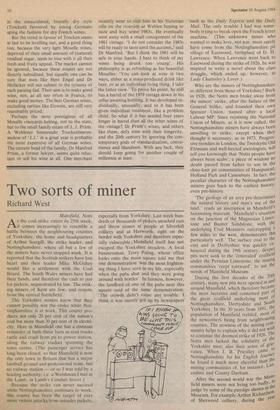Dr Priim's nectar
Harry Eyres
Trier Trier is 2,000 years old this summer, so the municipal authorities are busy sprucing up the city founded by Augustus
as Augusta Treverorum, later to become Treveris, capital of the far west of the Roman Empire, now a smallish provincial town on the canalised, but still vine-clad, banks of the Moselle. With ungermanic in- efficiency, they have left it all a bit late, and frustrated locals in stalled BMWs call it the City of the 2,000 roadworks. Still, by the standards of any other country, it is awesomely spick-and-span, and in parts gives the disconcerting impression, peculiar to German towns, of being brand-new despite its evident age. Trier has more Roman monuments than any other northern city, but its most im- pressive legacy from the Romans is not the Porta Nigra, the ruins of the Emperor's baths or the huge Basilica, but something
still very much alive and life-giving: the great carpet of vines which stretches for Perhaps a hundred miles along the banks of the Moselle and its two tributaries, the Saar and the tiny Ruwer. There were vines here
at the time of the emperor Probus (3rd cen-
tury AD), and a little later the poet Ansonius, usually associated with Château Ausone in St Emilion, sang the praises of the vine-green, fish-filled Moselle in idyllic hexameters.
Burrowed under the town are many miles tn. cellars. In one, belonging to the 13tsehOfliche Weingtiter, you can see a sec- 'ion of the Roman water main: built entire- , underground to protect the water from contamination, it is almost big enough for a man to stand in. Directly above, the direc- tor of the Weingtiter, Herr Richter, points c'ut, is where Karl Marx completed his bac- calaureate at the Friedrich-Wilhelm- GYrnnasium, a school which also owns fine vineyards. But Trier's most famous citizen is a prophet without honour in his home twown. He did his good work here,' Herr mchter goes on. 'His bad things he did in vift-ondon'. The fine 18th-century house stolidly Marx was born is little visited, but d°11dlY bourgeois Trier, oblivious to the ,°°tri of capitalism, shops assiduously at e"inother shrine bearing the family name, the technological emporium Modehaus Marx. Despite did revolutions which even Marx ."Iu. not envisage, and which have in- validated some of his theories, the barrels here called fader — down in the cellars "_ave not changed since Roman times: those depicted on a Roman sculpture of a wine- tvansporting boat, found at Neumagen entY miles down the Moselle, appear erical in size (1,000 litres) and shape. The Romans' vineyards and wine-making skills did not perish with the fall of their empire: they were preserved by the monks. The Bene,dictine abbey of St Maximin in Trier was making 900 fiider a year, a big production even by today's standards, in AD783. Probably its best vineyard, which still bears the name of the abbey, consists of one huge south-facing slope of a hill op- posite Mertesdorf on the Ruwer. The original monastic buildings of the Maximin Grunhaus, as it is now called, have been overlaid by later additions and converted into a beautiful country house, but the wine is still graded as it was in monastic times: that which comes from the top part of the hill, the strongest in flavour and supposedly the best, is labelled Abtsberg, as it was originally reserved for the abbot; the wine from the middle part, less rich but more delicate, bears the name Herrenberg because in olden times it was drunk by the choir monks; and the undeniably less good produce of the lower slopes is called Bruderberg, and was served to the novices. Even they were not doing badly, as all the wine from this vineyard in a good year possesses a unique fragrance and delicacy.
The vineyards of the Moselle, Saar and Ruwer celebrated the double millennium of Trier a year early: 1983 was the best vintage since the extraordinary drought year of 1976, which produced practically no or- dinary wine, and possibly the best typical vintage since 1971. Last year, most unusual- ly, the von Schuberts at the Maximin Griinhaus made wine in each of the seven different grades of quality laid down in the new German wine law (there used to be an almost infinite range), from straightfor- ward Qualitatswein and dryish Kabinett up in ascending order of sweetness through Spatlese and Auslese to Beerenauslese and Trockenbeerenauslese (made from in- dividually picked berries affected by Edelfaule or noble rot) and finally Eiswein, now a quality grade in its own right. The peculiarity of Eiswein is that the grapes must be picked, usually in the early hours of the morning, and crushed at a temperature several degrees below zero. The resulting wine is extraordinarily concentrated, a mix- ture of intense sweetness and equally in- tense fruity acidity, and it takes decades to achieve harmonious maturity. Nineteen eighty - three was a great Eiswein year because heavy frosts came in November when the ordinary picking was hardly com- pleted. Sometimes the grapes reserved for Eiswein have to be left until December or January, and then with no pickers on hand the vineyard owner has to gather up family and friends and go out in the middle of the night risking frostbite for the sake of a few bottles of the next century's nectar.
There is, quite simply, no other wine- producing area where quality is sought so single-mindedly as in these estates on the Moselle and Rhine. They have none of the big business element which exists in Bordeaux or the mercenary canniness which characterises so many growers in Burgundy. In fact, many of them are not private enter- prises at all but belong to the state. In case nationalised vineyards might suggest something on the lines of NCB or British Rail, it should be made clear that the Ger- man state-owned wine estates exist to set a standard for other wine growers, to make the best possible wine at a fair price, and to pursue research into viticulture and wine- making. Sometimes talking to the director of one of these estates (Herr Engel of the Friedrich-Wilhelm-Gymnasium, or Dr Hofacker at Niederhausen on the Nahe) one seems to be in the presence of the head of a research institute or museum, not of a business. Not that they are completely out of touch with commercial reality: all the top estates now make a proportion of their wine
in the emasculated, brutally dry style (Trocken) favoured by young Germans aping the fashion for dry French wines.
But the trend in favour of Trocken seems at last to be levelling out, and a good thing too, because the very light Moselle wines, deprived of their small amount of (natural) residual sugar, seem to lose with it all their fresh and fruity appeal. The market cannot be ignored, because these estates are not directly subsidised, but equally one can be sure that men like Herr Engel and Dr Hofitcker will not submit to the tyranny of each passing fad. Their aim is to make good wine, not, as all too often in France, to make good money. The best German wines, excluding rarities like Eiswein, are still very reasonably priced.
Perhaps the most prestigious of all Moselle vineyards belong, not to the state, but to the small family estate of J. J. Priim. A Wehlener Sonnenuhr Trockenbeeren- auslese of `J.J.' in a great year is probably the most expensive of all German wines. The current head of the family, Dr Manfred Prum, a former lawyer, seems quite reluc- tant to sell his wine at all. One merchant recently went to visit him in his Victorian villa on the riverside at Wehlen hoping to taste and buy some 1983s. He eventually went away with a small consignment of the 1981 vintage. 'I do not consider the 1983s will be ready to taste until the autumn,' said Dr Manfred. 'But I think the 1981 will be safe in your hands. I hate to think of my wines being drunk too young'. His philosophy is as refreshing as his beautiful Moselles: 'You can look at wine in two ways, either as a mass-produced drink like beer, or as an individual living thing. I take the latter view.' To prove his point, he still has a barrel of the 1979 vintage down in his cellar awaiting bottling. It has developed in- dividually, unusually, and so it has been given individual treatment, like a problem child. So what if it has needed four years longer in barrel than all the other wines of the vintage? Dr Prtim's wines, and others like them, defy time with their longevity, and the 20th century by ignoring the con- temporary gods of standardisation, conve- nience and blandness. With any luck, they should keep going for another couple of millennia at least.







































 Previous page
Previous page